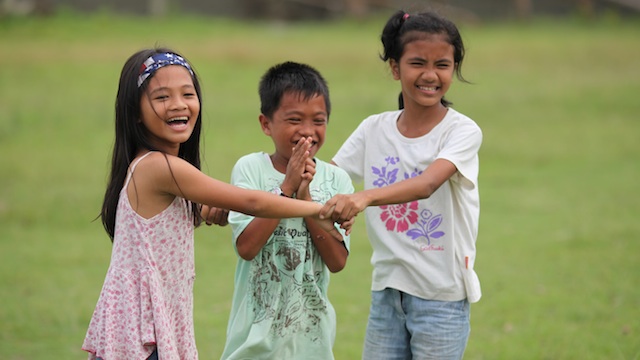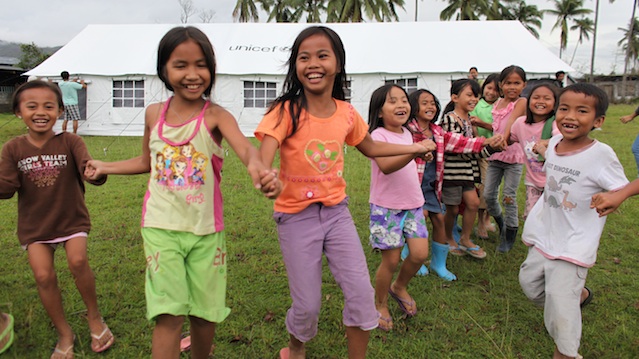SUMMARY
This is AI generated summarization, which may have errors. For context, always refer to the full article.
*As told to Ana P. Santos by Yul Olaya, UNICEF Education in Crisis officer
When doing a news report on a national calamity the magnitude of Typhoon Pablo, a journalist is often constrained by word count and ever shrinking attention spans to limit the information to pertinent facts.
There is little time or space left to show how the people who have been struck by disaster are affected. We’re taking a look beyond the numbers to see how a seemingly permanent institution like education can be forever changed by a typhoon that takes everything away.

We were inspecting one of the disaster areas when I saw a Grade 3 pad paper, you know, the ones that are lined in red, blue for kids to practice lettering and such. It read: Sana po makatapos ako ng pag-aaral. (I wish I could complete my education.)
We found the crumpled and muddied paper in the wreckage that was once a school. I didn’t know when the child scribbled this down – if it was before, or after Typhoon Pablo. Before Pablo, the note would read like a simple but fervent wish of a diligent student. Now, after Pablo, the note reads like a question that desperately waits to be answered.
The impact of Pablo on the education sector, both in ComVal and in Davao Oriental, is huge. The storm left both the students and their teachers with nothing, no home to live in, no school to go to. What we have here is an education system that is totally damaged, not just physically [in terms of structures].
We have an education system that is designed for normal situations, we do not yet have one that is resilient to emergency, especially in this area that is not used to natural disasters.
I talked to one child who said, “Wala na. Wala na akong school.” (No more. I have no more school.) He seemed so desolate and forlorn; even if he wanted to go back to school, there was no school to go back to.

Some schools were totally destroyed and some were totally swept away by the winds. In the eyes of a child, without the physical structure of a school building, how could he ever go back to school? The total destruction of a school – the absence of a school – sends an underlying message that they cannot go back to school, even if they wanted to.
In the plaza, the only structure that remains is the statue of Andres Bonifacio holding up the KKK flag. It is somehow symbolic that this is where we decided to set up a tent to be used as one of the temporary learning centers for the children. Here the kids can have informal sessions using drama and art to process the trauma of their experience. Children are known to be incredibly resilient, even sometimes more than adults, but they need an outlet to speak and to know they are not alone in what they are going through.
It is a challenge, for sure, to maintain these temporary learning spaces. The rains continue to come and the parents fear the possibility of being separated from their children. (Read more about the other weather disturbances that continue to occur in the eastern Mindanao area after Pablo.)
The teachers are also struggling with the challenge of having multi-age, multi-grade students under one tent. For now, we are working on a shifting schedule so that the children can share the space.
The learning spaces also serve another purpose. They provide a place where the teachers and the students can gather. The interaction between the teachers and the kids provides a great relief to both. It establishes some kind of normalcy and it sends a strong message that together, we can move on. In spite of the nothingness that surrounds us, there is still hope.
The dedication of teachers
The teachers are incredibly dedicated. In the beginning of the calamity, we found a number of them, instead of working on their homes, digging through mud and debris, desperately trying to recover class records.
How were they going to promote their students to the next year level without these records, they asked. It may seem like a small thing, but class records, the tracking and monitoring of the progress of the students they educate, are the very things that define them as teachers.

Before this, the quality of education in the area was comparable to other areas in the country. In Cateel Elementary School, the only thing left standing is a flagpole. There is no flag – Pablo took that away. But before Pablo, this was one of the best performing schools in the region. The students were performing well in academic contests and they won Brigada Eskwela awards and citations. (Brigada Eskwela is an annual event sponsored by the Department of Education where volunteers pitch in to repair and clean up public schools before the start of an academic year.)
In the area, there is a very low drop-out rate. Almost all of the children are able to receive formal schooling. They want to go to school; they want to learn.
This is the first time the education system is forced to respond to devastation of this magnitude. It is a place of children who are now left with nothing.
Now, we have to find a way to re-build the education system Pablo destroyed and make it even stronger than these children’s will to survive. – Rappler.com
Add a comment
How does this make you feel?
There are no comments yet. Add your comment to start the conversation.